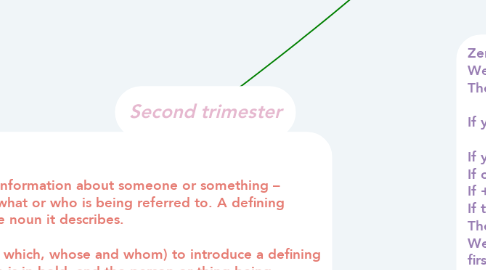Second trimester
by Sara Reyes

1. Relative clauses: defining and non-defining Defining relative clauses We use defining relative clauses to give essential information about someone or something – information that we need in order to understand what or who is being referred to. A defining relative clause usually comes immediately after the noun it describes. We usually use a relative pronoun (e.g. who, that, which, whose and whom) to introduce a defining relative clause (In the examples, the relative clause is in bold, and the person or thing being referred to is underlined.): They’re the people who want to buy our house. Subject or object The relative pronoun can define the subject or the object of the verb: They’re the people who/that bought our house. (The people bought our house. The people is the subject.) No relative pronoun We often leave out the relative pronoun when it is the object of the verb: They’re the people she met at Jon’s party.
2. FUTURE PERFECT & FUTURE CONTINUOUS SHAPE The perfect future is made up of two elements: the simple future of the verb "have" (I HAVE) + the PARTICIPLE of the main verb. Subject + will have + past participle of the main verb Subject + will have + past participle of the main verb FUNCTION The perfect future refers to an action completed in the future. When we use this time, we are projecting ourselves into the future, towards an action that will be completed later than now. Most often used with a time expression FUTURE CONTINUOUS the future continuous is made up of two elements: the simple future of the verb ‘to be’ + the present participle (base+ing) You will be climbing. FUNCTIONS The continuous future refers to an unfinished action or event that will be in progress in the future.
3. Zero, first, second and third conditional: The Zero Conditional We use the zero conditional to talk about permanent truths, such as scientific facts, and general habits. The structure is simple Here are some examples: If you heat water to 100°, it boils. If you eat a lot, you put on weight. If clause (condition) Main clause (result) If + simple present simple present If this thing happens that thing happens. The First Conditional We use the first conditional to talk about a realistic situation in the present or future. The structure of the first conditional is as follows: In the first conditional sentences, the structure is usually: if/when + present simple >> will + infinitive. It is also common to use this structure with unless, as long as, as soon as or in case instead of if. I'll leave as soon as the babysitter arrives. I don't want to stay in London unless I get a well-paid job. Second conditional The second conditional is used to imagine present or future situations that are impossible or unlikely in reality. If we had a garden, we could have a cat. If I won a lot of money, I'd buy a big house in the country. I wouldn't worry if I were you. The structure is usually: if + past simple >> + would + infinitive. When if is followed by the verb be, it is grammatically correct to say if I were, if he were, if she were and if it were. However, it is also common to hear these structures with was, especially in the he/she form Second conditions lThe second conditional is used to imagine present or future situations that are impossible or unlikely in reality.If we had a garden, we could have a cat. If I won a lot of money, I'd buy a big house in the country. I wouldn't worry if I were you.The structure is usually: if + past simple >> + would + infinitive. When if is followed by the verb be, it is grammatically correct to say if I were, if he were, if she were and if it were. However, it is also common to hear these structures with was, especially in the he/she form.
4. sara reyes 9a


